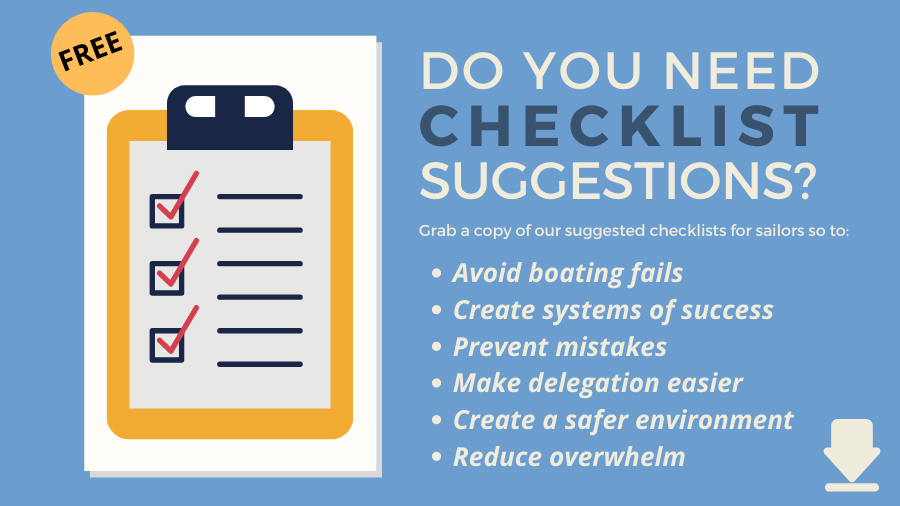The boat briefing checklist is a comprehensive list set out to help you or your skipper introduce your boat to guests and crew. It goes through everything on deck and below – what it is and how it works.

The Boat Briefing Checklist provides the opportunity for a good discussion on safety devices and emergency procedures.
Furthermore, it provides an opportunity to discuss any medical issues and highlight the importance of everyone looking out for each other.
It’s very possible that you’ll have people on board that is not accustomed to boats. They may not understand how the toilets or drainage pumps work, why they should wear shoes when walking on deck or the seriousness of an injury. When you’re out sailing, calling 999/911 or making a VHF MAYDAY broadcast won’t necessarily get a response in minutes – it could be hours and in some cases days.
By offering a boat briefing upon the arrival of new guests you’ll be able to cover all the major points important to you.
The salty seadogs would surely balk at my extensive list and say, ‘let newcomers figure things out for themselves,’ but that’s just rude and no longer acceptable.
Furthermore, by having discussions about the way things work, you’ll be less likely to be put in a position where you or your skipper is pulling out a wet wipe from your dismantled toilet macerator, taking a guest to emergency due to dehydration or dying because you failed to cover the Man Over Board (MOB) procedure.
Boat Briefing Checklist
Up on deck
- Basics: getting on and off the boat safely
- Moving around: what you can walk on, hold onto and clip yourself to (jackstay)
- Deck hazards: shoe policy, hatches, boom, and any other hazard area
- Lines and winches: basic use and hazards to be aware of
- Lockers: where they are and the contents (Fender storage, cleaning supplies, safety equipment location, and gas)
- Tender: how it’s used
- Engine: turning it on/off and how to operate. Emergency turn-off
- Instruments and GPS: a quick overview
- Teamwork: report any injuries, breakages, concerns or illnesses immediately
- Sun protection: hats, sunscreen
- Hydration policy: everyone must be seen to be drinking water throughout the day
- Seasickness: symptoms, ways to avoid it, what to do if you get it
- Medical: Medical questionnaires filled out (See Medical Questions Form For Guests/Crew Members in the book)? Ask crew: Any allergies? Anyone that can’t swim? Medical conditions? Food allergies? Diabetes, epilepsy, heart condition, etc. Discuss each other’s medical status, medication
Emergency equipment – Boat Briefing Checklist
- Man Over Board (MOB): the purpose of the equipment, MOB procedure, and MOB buttons/alerts, life raft, etc. Note: if you do fall in, go into a fetal position
- Other emergencies: What to do in the case of a demasting, fire, flood or loss of the rudder/steering
- MAYAY instructions: Make a note that you’ll show the crew the VHF and MAYDAY procedure below decks
- Life raft: purpose and procedure for use
- EPIRB/SART: purpose and procedure for use
- Flares: location, use, and precautions
- Life raft survival grab bag: location, purpose, and contents
- Emergency tiller: location and how to use
- Fuel cut-off: location and how to use
- Emergency skipper: who will take the role of the skipper if the skipper becomes incapacitated?
Below decks
- Moving around: handholds, slipping and companionway steps
- Lifejackets and harnesses: distribute, adjust and discuss when and where to wear
- First Aid Kits: locations, equipment, logbooks, and procedure for requesting First Aid. Mention who the designated First Aider is.
- VHF Radio: show how to turn on and follow instructions for MAYDAY call
- Torches and searchlights: locations
- Circuit board: an overview of switches, how the electricity works, navigation lights
- Fire extinguishers and blankets: location and how they work
- Hatches: dangers and making sure they’re closed at sea
- Heads: how to use, no toilet paper! Also mention that lack of water in the head is a serious danger and should be reported immediately
- Sinks/showers: how to use and how to clean up afterward
- Water: drinkable/not drinkable? Explain water is in short supply!
- Galley: location of everything, dangers (gas, slamming doors, burns), and how each appliance operates. Important that everyone keeps galley clean
- Cleanliness: everything needs to be put back from where it came from
- Flooding: bilge pumps, stopcocks, plugs, and bailing
- Garbage: general waste and hazardous waste policies
- Other:
Are you interested in more information about checklists for sailors?
- Check out all our checklist articles and videos here: Checklists
- Get 50+ Checklist Suggestions here: Suggested Checklists For Sailors
- Also, check out our shop for a variety of guides that include checklists here: Britican Shop
